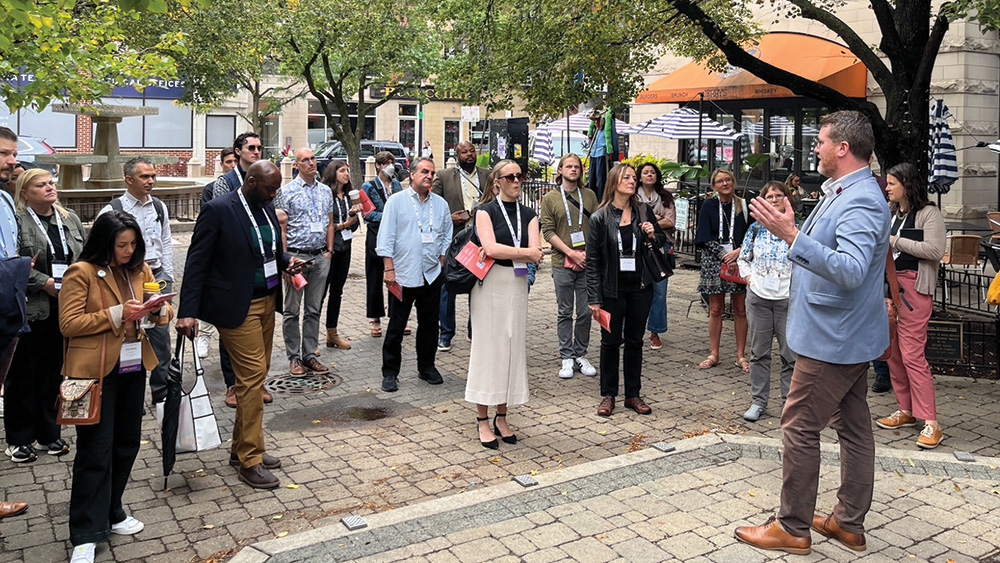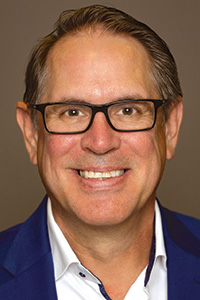
IDA conference attendees ventured out into Chicago neigborhoods, where they learned about the impact of public-private partnerships in areas including Lincoln Square, above. (Photo courtesy Teska Associates)
When IDA, which was founded in 1955 as the International Downtown Association, announced that the Chicago Loop Alliance was co-hosting IDA’s 2023 Annual Conference & Marketplace, it might have seemed a safe bet that the event would stay within the boundaries of the 35 downtown blocks encircled by the city’s elevated trains, an area nicknamed “the Loop” more than a century ago.
And much of the Oct. 4-6 conference did take place in the Loop, including panels, talks, and a 50-vendor exhibit hall at the conference hotel, the Palmer House Hilton, as well as opening and closing receptions, at the Merchandise Mart and the Museum of Contemporary Art Chicago. But the overall conference footprint was far more expansive, as attendees ventured into the city’s neighborhoods and surrounding suburbs, through a series of 23 tours and mobile workshops. They included visits to the restored Pullman neighborhood, founded in 1880 as the first industrial planned community in the U.S., built on Chicago’s South Side for the employees of the Pullman railroad car company ; the vibrant mural-filled Rogers Park neighborhood in the city’s far North Side; and a day-long tour of Naperville, 33 miles west of downtown Chicago.
Beyond ‘Downtown’
The inclusion of areas beyond those traditionally defined as downtown business districts reflects the evolution of the 70-year-association, said David Downey, IDA’s executive director. This year, the association dropped the name International Downtown Association in favor of IDA, partly to get away from the U.S.-centric term “downtown” — the term “city center” is more common globally — but also to emphasize that place-based economic development occurs in suburban city centers and commercial neighborhoods as well as in central business districts.

David Downey
The Chicago Loop Alliance was a leading proponent of the plan “to really embrace, not just downtown, but what’s happening throughout the city of Chicago,” Downey said. The alliance, a public-private partnership, wanted to shine a spotlight on the transformative programs taking place throughout the city, and to underscore the fact that, with thousands of residents, the Loop itself is as much a neighborhood where people live as a business district.
One of the lessons of the last few years has been that mixed-use areas with strong residential bases — like the Loop — fared better during the pandemic than those central business districts that were emptied out when office workers stayed home, Downey said.
The pandemic “put a freeze on downtowns’ primary advantage as a place where people gather, create, and seek entertainment,” according to a 2023 global trends report commissioned by IDA and created by Progressive Urban Management Associates. The pandemic accelerated changes — including the rise of remote work and the decline of traditional retail — that had been in motion for years, the report concluded. It also pointed to the growing homeless population as the “most visible” symptom of America’s gaping inequality.
IDA didn’t shy away from wrestling with those deep-rooted social and civic issues of homelessness, the housing crisis, and wealth inequity at the conference, but there were also success stories of economically vibrant downtowns and commercial neighborhoods. Conference speakers included Robin Rue Simmons, a former alderman in Evanston, Illinois, where she helped lead the passage of the first municipally funded cash reparations legislation for Black residents in the U.S. Participants also heard from Vincent Ray Williams, who, while homeless himself, founded the Urban Compassion Project, an initiative to keep Oakland, California’s parks clean so that children who are unhoused have a safe place to play.
This “is a profession that offers innovation,” Downey said. “We want to lean into those conversations about the challenges that our cities face.” Another theme of the conference — and an IDA mantra — is the need for collaboration between nonprofit organizations, businesses, and government to create integrated solutions to community problems. “No one entity can solve this alone,” Downey said.
Record Growth
The conference itself is flourishing, with this year’s attendance at a record high — nearly 1,500 attendees, up from 1,000 at the 2022 conference in Vancouver, Canada. One factor that contributed to its growth, Downey said, was that the association was “able to solidify our programming and fully publish all available content well in advance, where in the past, admittedly we kind of trickled out the content over a series of registration and pre-registration deadlines,” he said. And secondly, he added, “Chicago is super accessible and is one of America’s great cities.”
But the most important factor was what Downey described as a “phoenix rising from the ashes.” Going into the pandemic, “we knew that we were going to see a significant kind of turnover of professional leadership across this industry with the retiring baby boomer CEOs and leaders,” he said. And now, “a couple of years after the pandemic, I think we have an entire new generation of professional leadership looking to rebuild their communities.”
Last year, IDA members were “trying to get their footing and understand what recovery was going to look like,” Downey added. “And this year, they were really leaning into the need to connect with one another, identify best practices, and have these deep community discussions, to really move forward for what will be a whole new era of city building.”
How to Nurture Young Leaders
Eight years ago, IDA established an Emerging Leaders Fellowship, an annual week-long experiential program designed to equip 30 young professionals from diverse backgrounds and geographies in place management with leadership and industry-specific skills. The standalone program is not held in conjunction with IDA’s annual conference but takes place every summer in New York City. The location is ideal, IDA’s David Downey said, “because there are small, medium, and large districts in NYC that make it relevant to all attendees, no matter where they come from.”
IDA offers additional leadership development programming online but puts a premium on in-person gatherings. “What we’ve come to realize is that we are strongest when we have these smaller, face-to-face activities that are building really deep professional peer-to-peer bonds,” Downey said. “Our annual conference is really becoming an opportunity where, over years of smaller, deeply engaged peer-to-peer engagements, we now see everyone coming back to the national event as an opportunity to reconnect with all of those various relationships that have been formed.”
Barbara Palmer is deputy editor of Convene.
